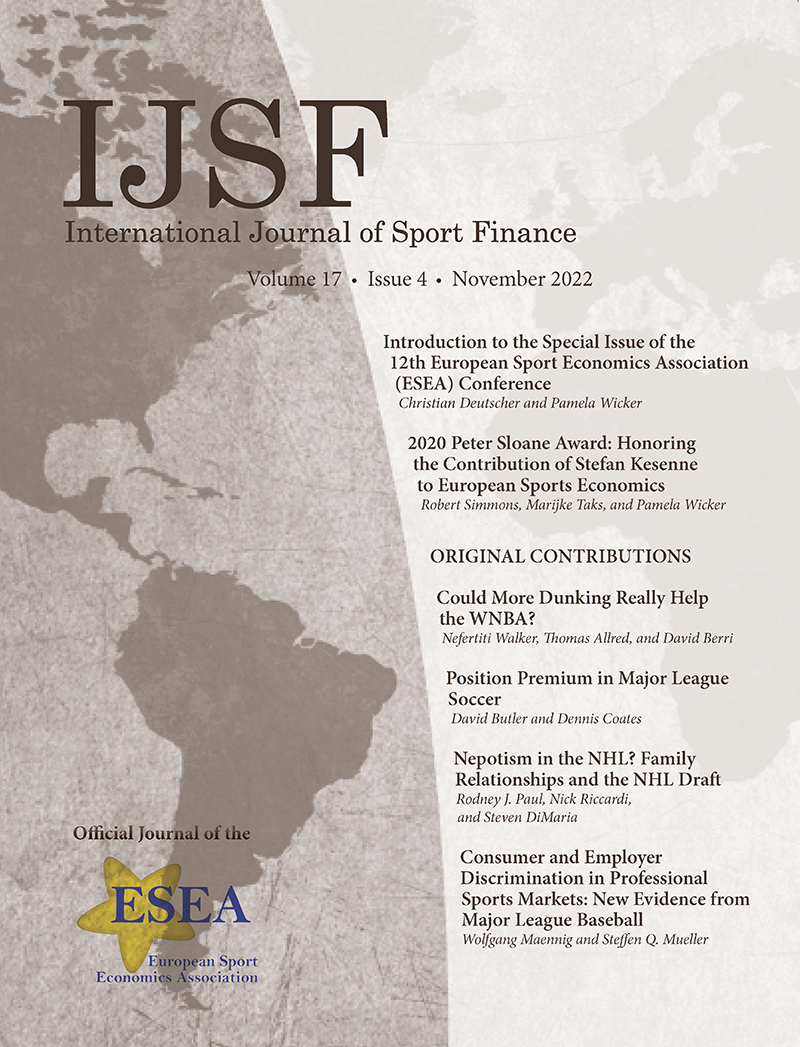International Journal of Sport Finance
Issue 17:4 – November, 2022
Issue 17:4 – November, 2022

Motivated by a comment Shaquille O’Neal made about the Women’s National Basketball Association (WNBA), we ask the following question: Is consumer demand and revenue in sports driven by the entertainment spectacle of the contest or the emotional attachment derived from wins and losses? We answer this question by empirically examining gate revenue in the National Basketball Association (NBA) from 2000‒01 to 2018‒19. Utilizing a linear regression with panel corrected errors, we examined the impact on factors like dunking, three-point shooting, star power, and team wins on team gate revenue. Our findings indicate that basketball fans very much care about winning, but they are less interested in how those wins are achieved.
JEL Codes: Z20, J16
This research estimates the effect of specific player position on salary in Major League Soccer. We expand a mincer-style wage equation with indicators for precise roles as defined by the Football Manager™ simulation. Our salary data covers 1,174 salaries for the 2019 and 2020 seasons. We match this to 17 positions and consider generalist and specialist functions in wage determination. Estimating ordinary least squares and quantile regressions, we find that defensive salary penalties are incurred only by specific peripheral defensive and wing back positions. Premia exist for versatile, attacking midfield players. We show that multi-positional players—those that play in multiple positional zones—earn a premium. The findings bring nuance to any specialist-generalist debate as versatile defensive players incur a penalty whereas versatile attacking midfield players earn a premium. Practically, the results speak to player unions, intermediaries advising players on their developmental needs, and franchises who must optimize salary budgets.
This research investigates player career performance compared to their National Hockey League (NHL) draft position as it relates to nepotism and physical/human capital transfer. After identifying family members of former players, we analyze their performance compared to others using a sample of over 1100 players from the 2005‒2010 drafts. We find no evidence of nepotism as it relates to sons in relation to earnings and only slight possible evidence in terms of reaching a low minimum games-played threshold. Although sons appear to be drafted appropriately, players with NHL siblings appear to be significantly undervalued as they outperformed their peers.
This study investigates the relationship between consumer discrimination, racial matching strategies, and employer discrimination in Major League Baseball (MLB) from 1985 to 2016. Specifically, we assess the extent to which both fan attendance and team performance respond to changes in teams’ and their local market areas’ racial compositions. To this end, we use game-level data (N = 69,239) that we aggregate to the team-season level (N = 866). Using facial recognition software and pictures on more than 7,000 players, each player is assigned to one of three race groups: White, Black, and other (Asian or Hispanic). We find both consumer and employer discrimination; discrimination varies across leagues, over time, by race and athlete groups, and regional racial composition. However, league-specific fan and employer racial preferences only partially align, indicating that employer discrimination is not primarily driven by fans’ racial preferences.
JEL: C5, J1, Z2